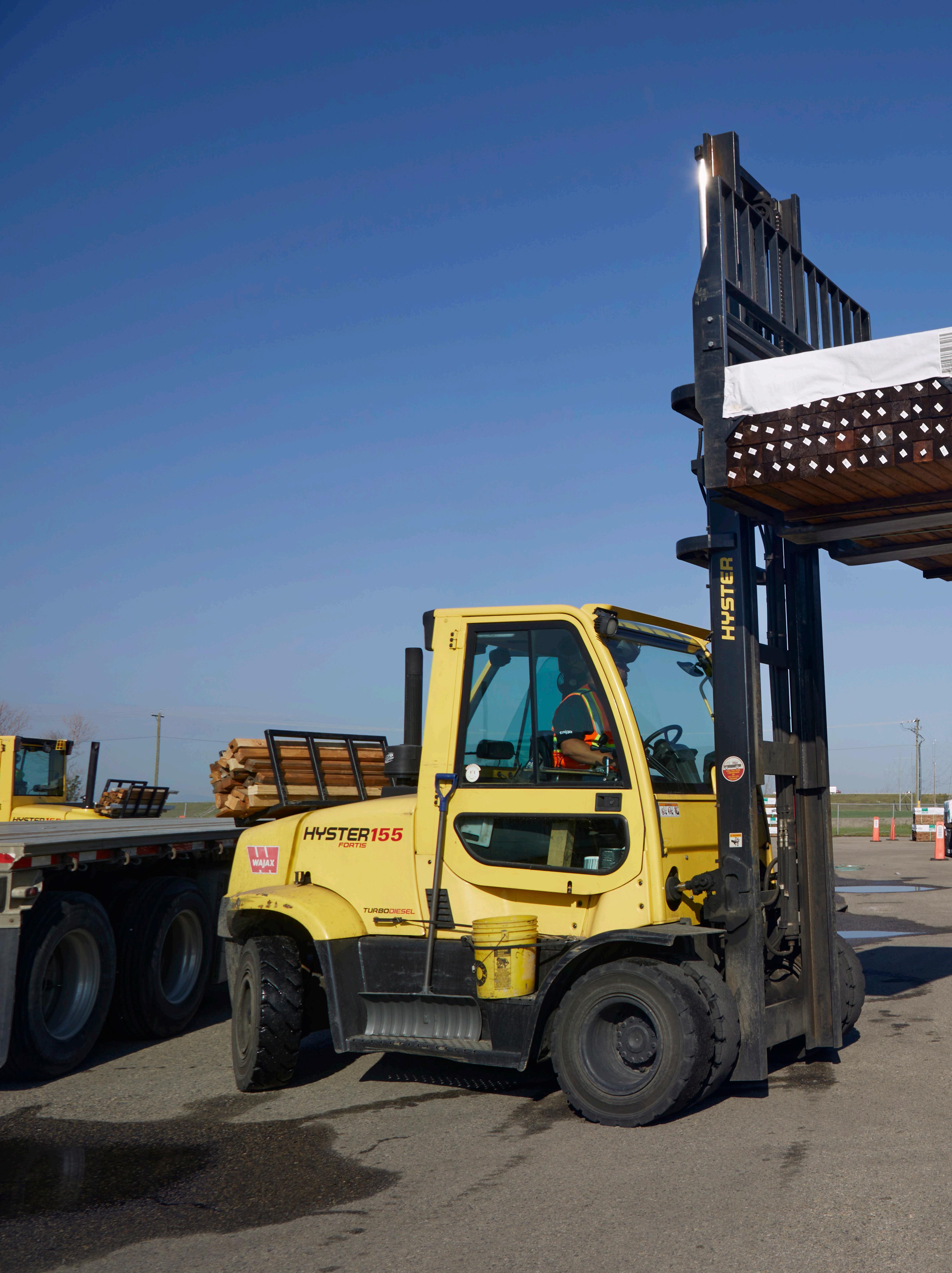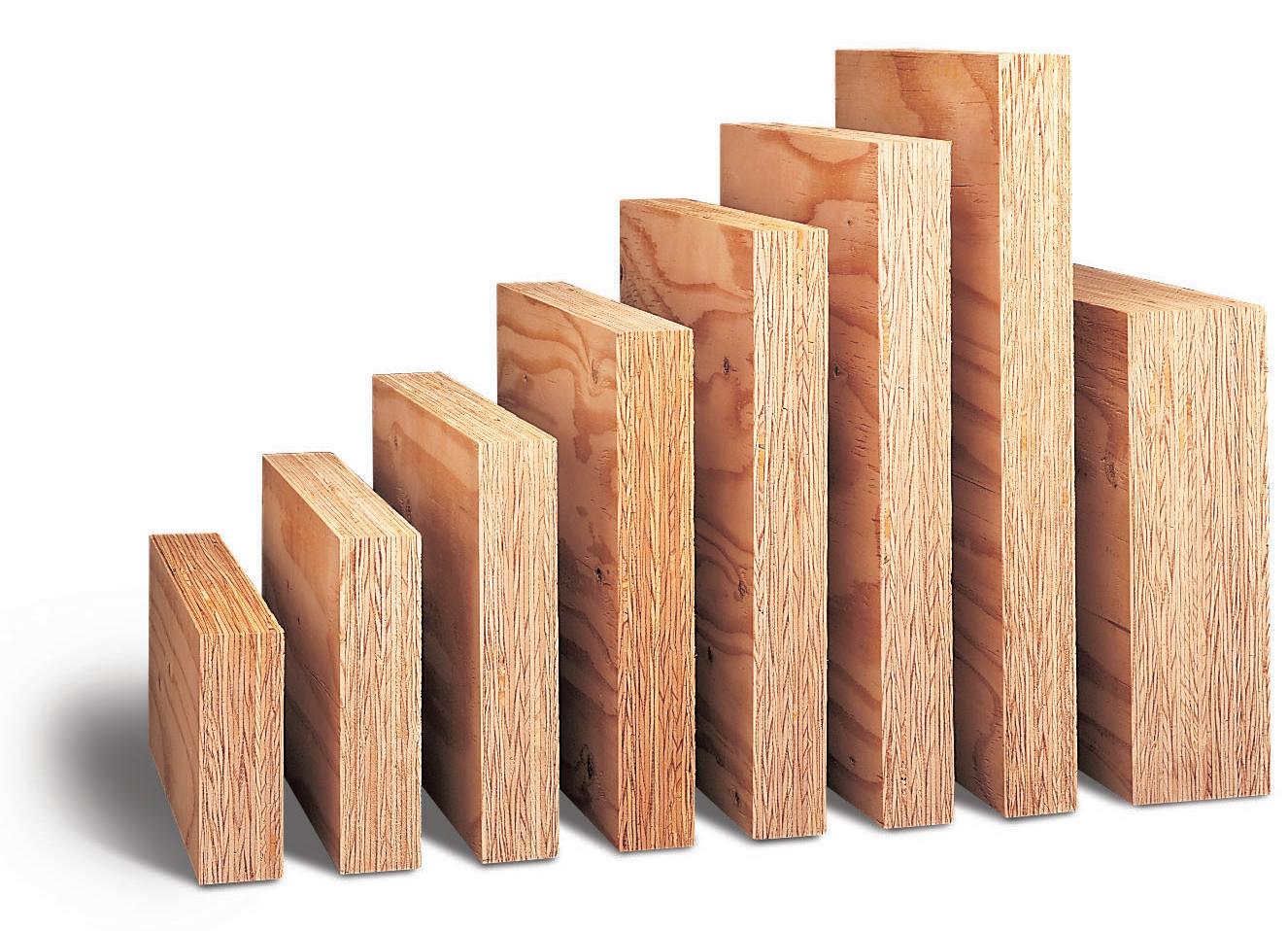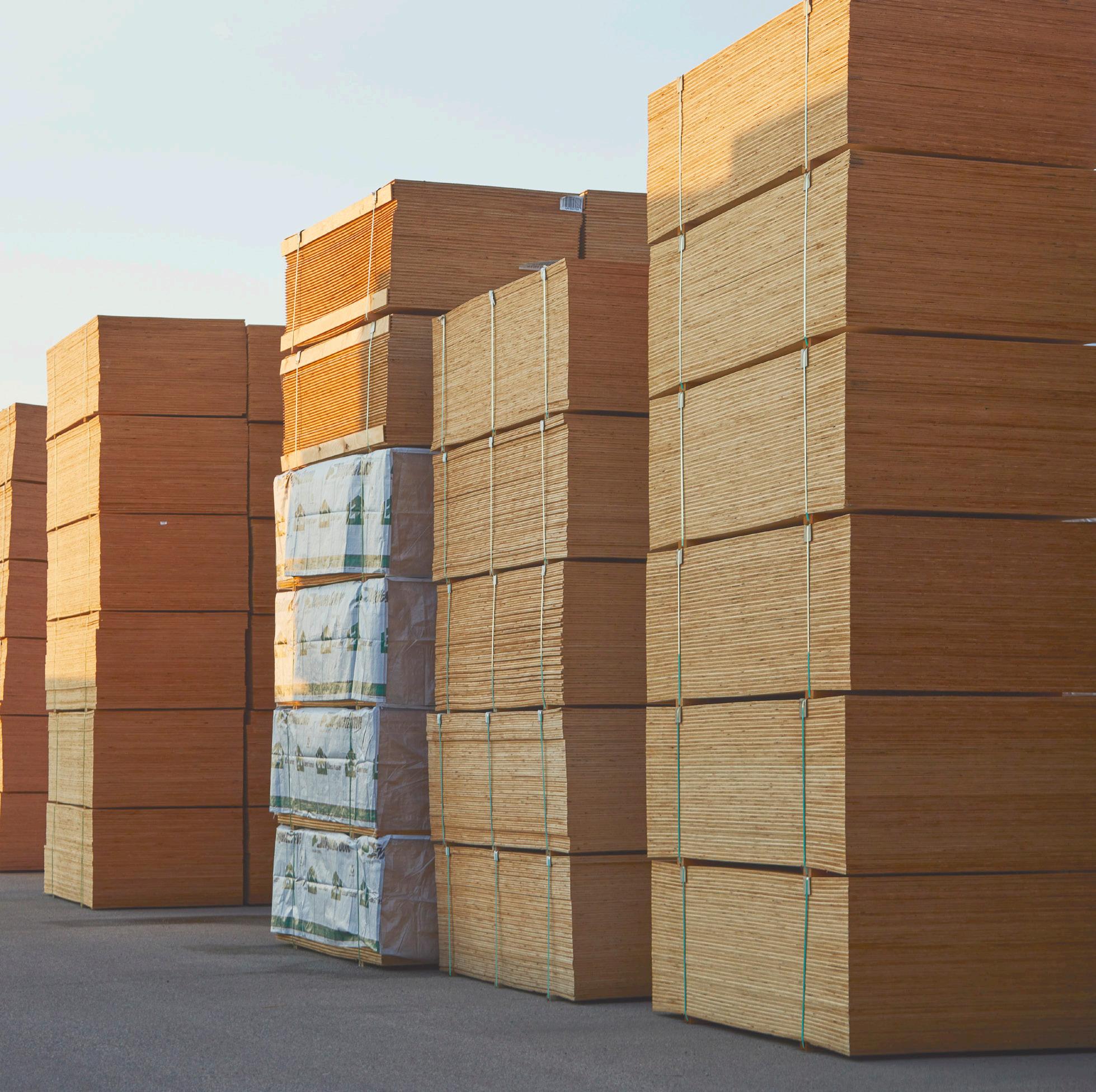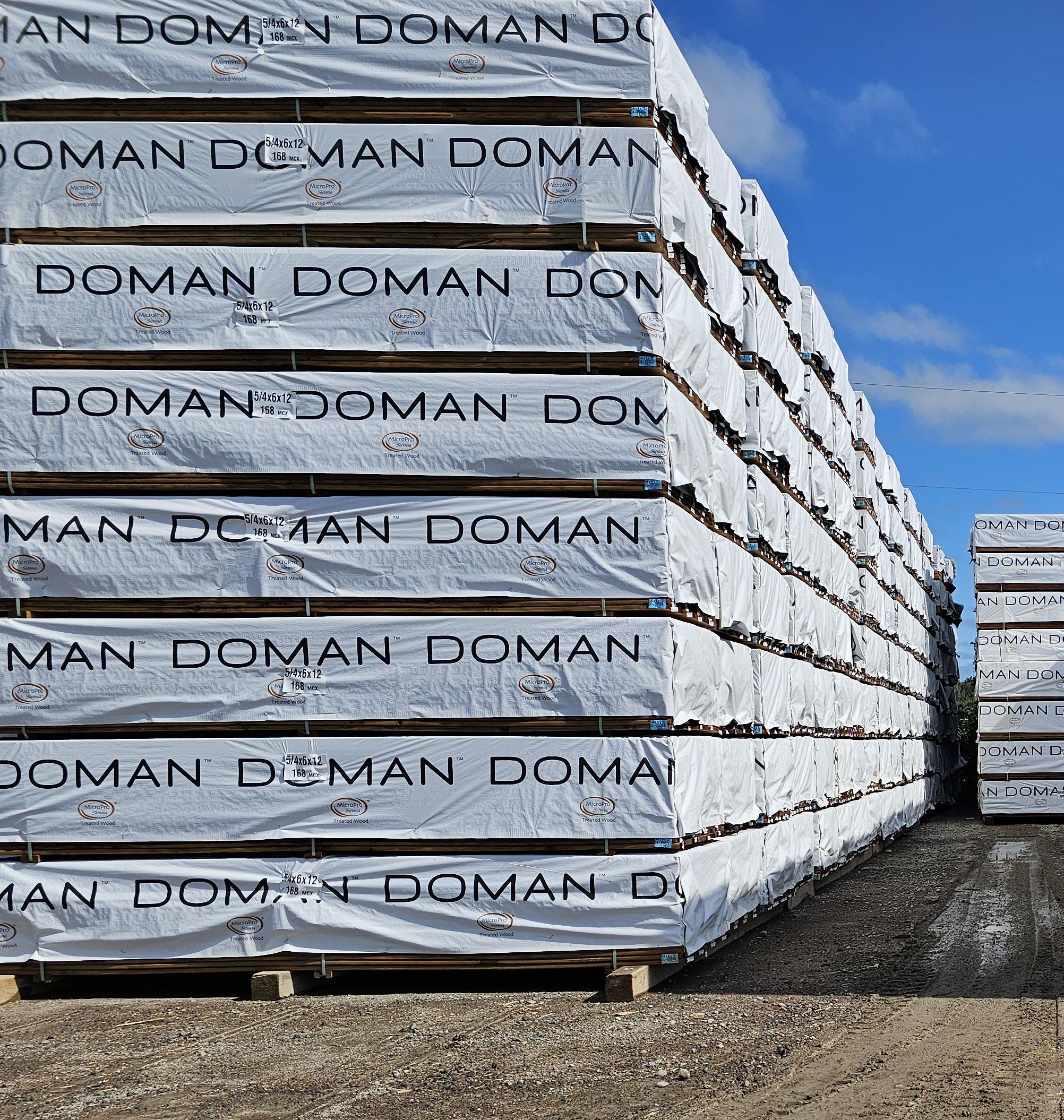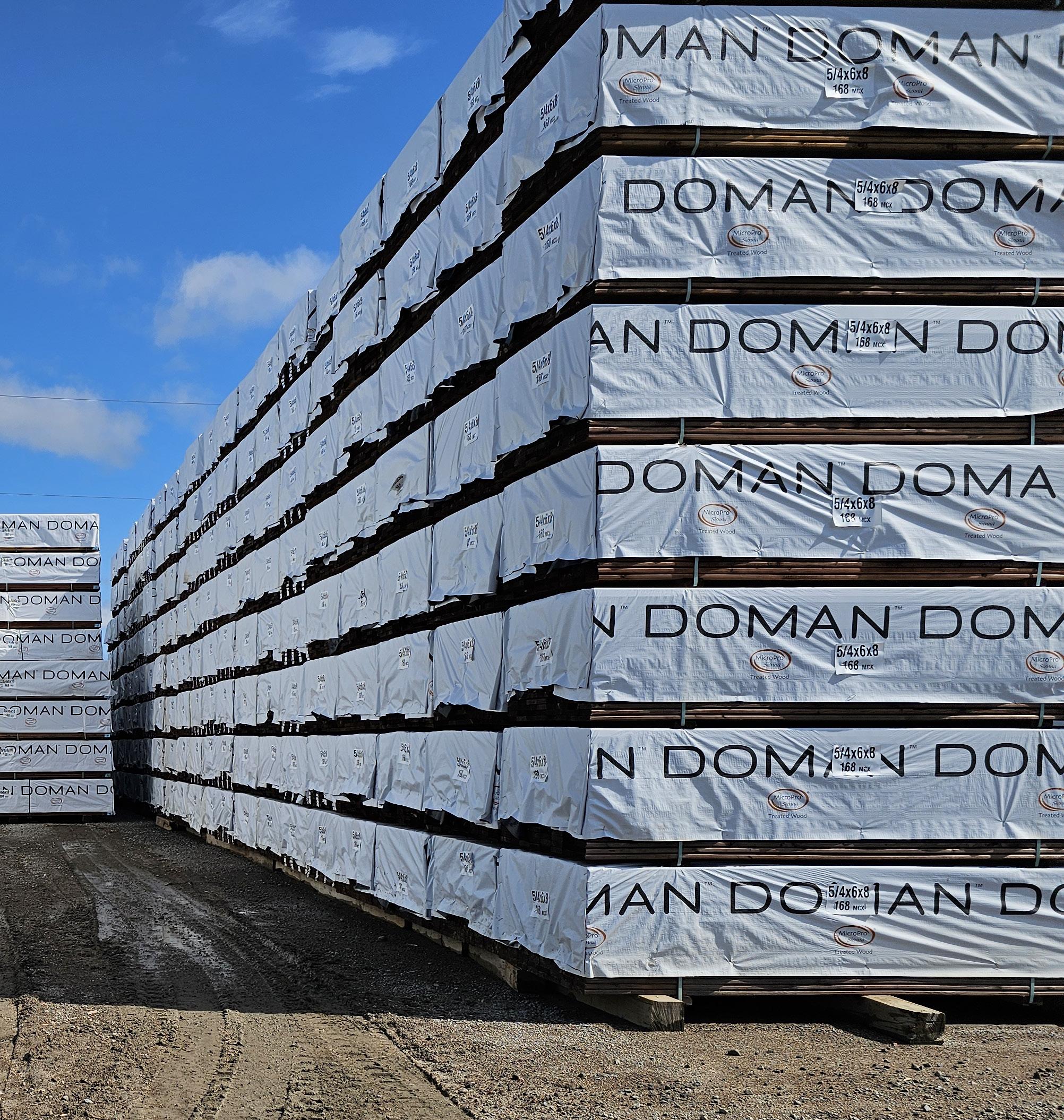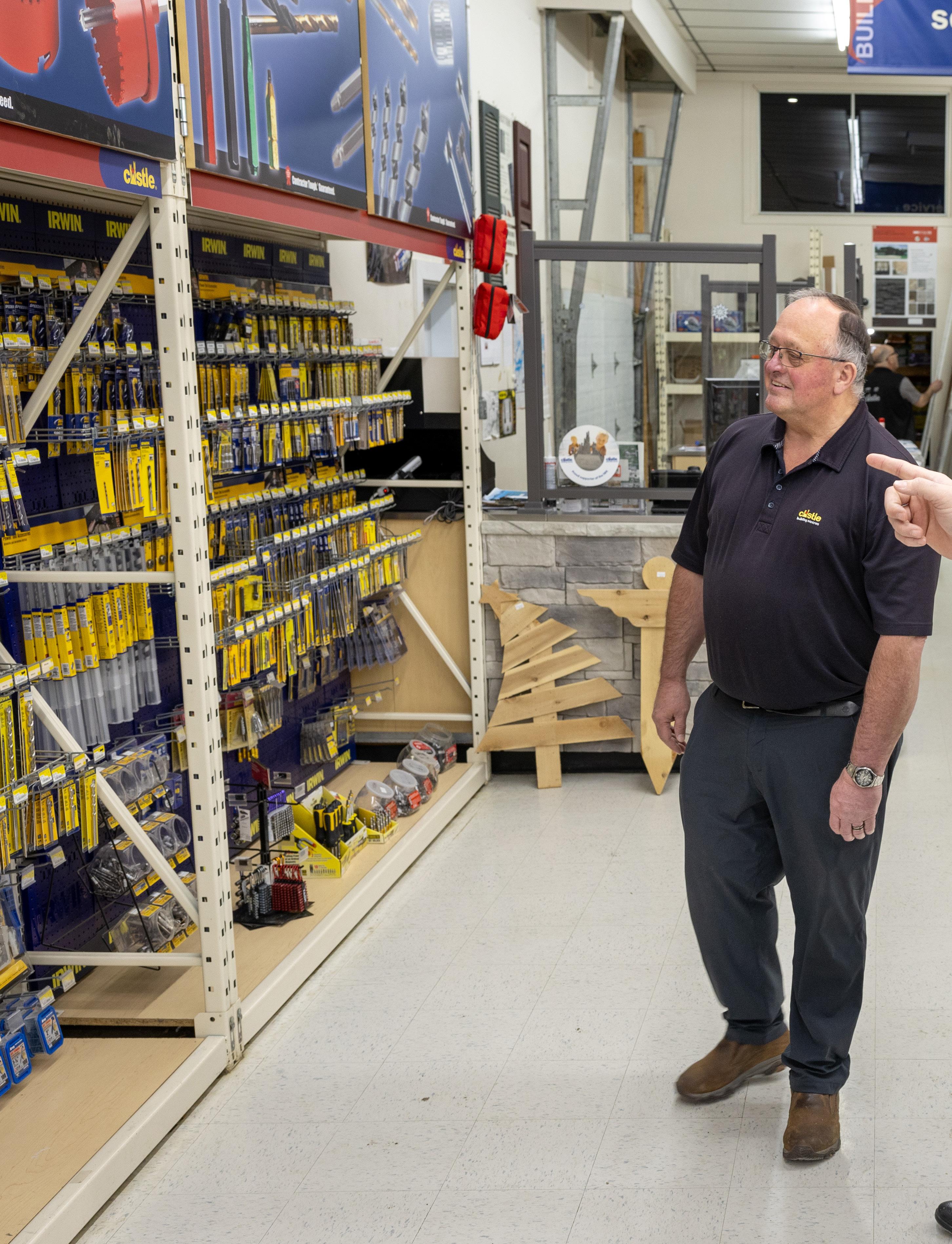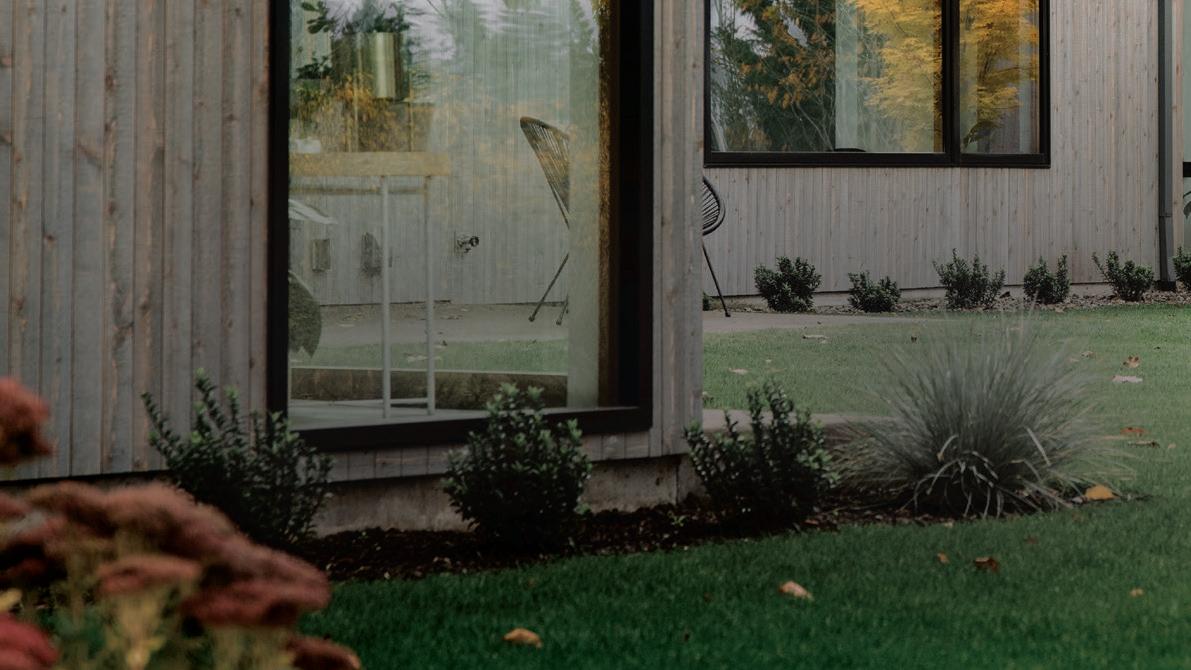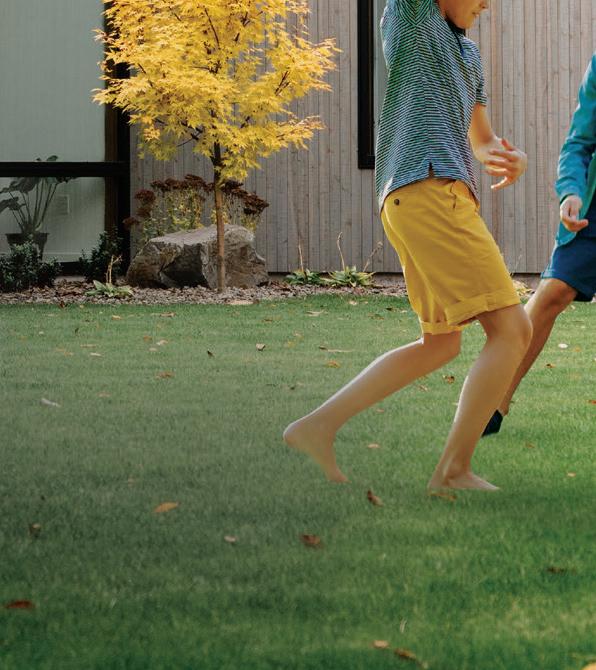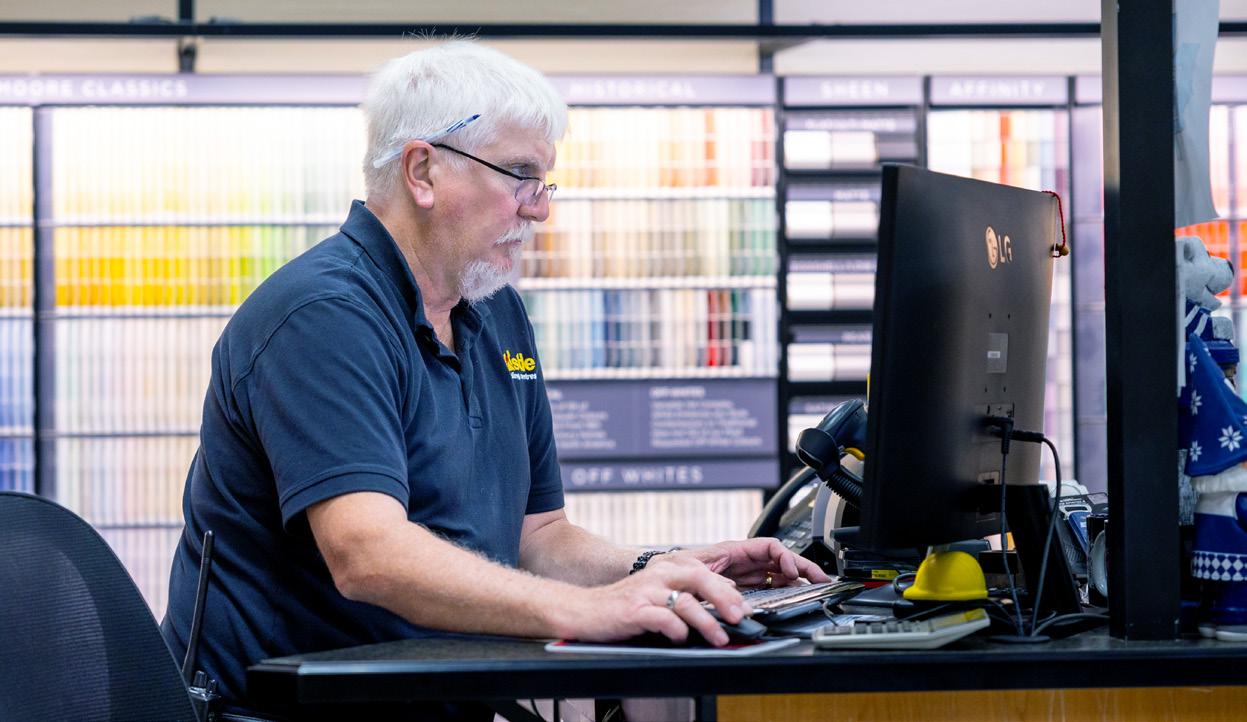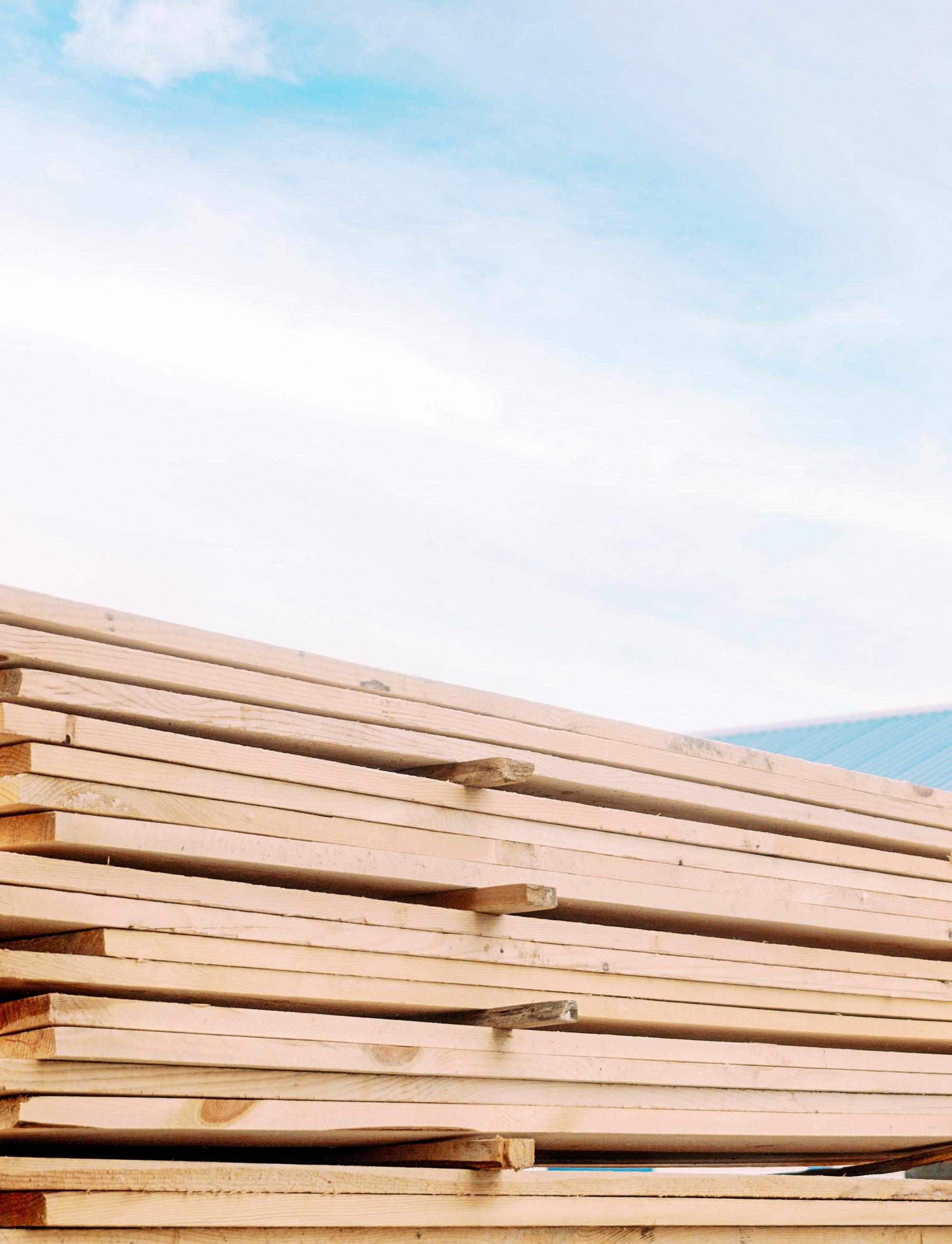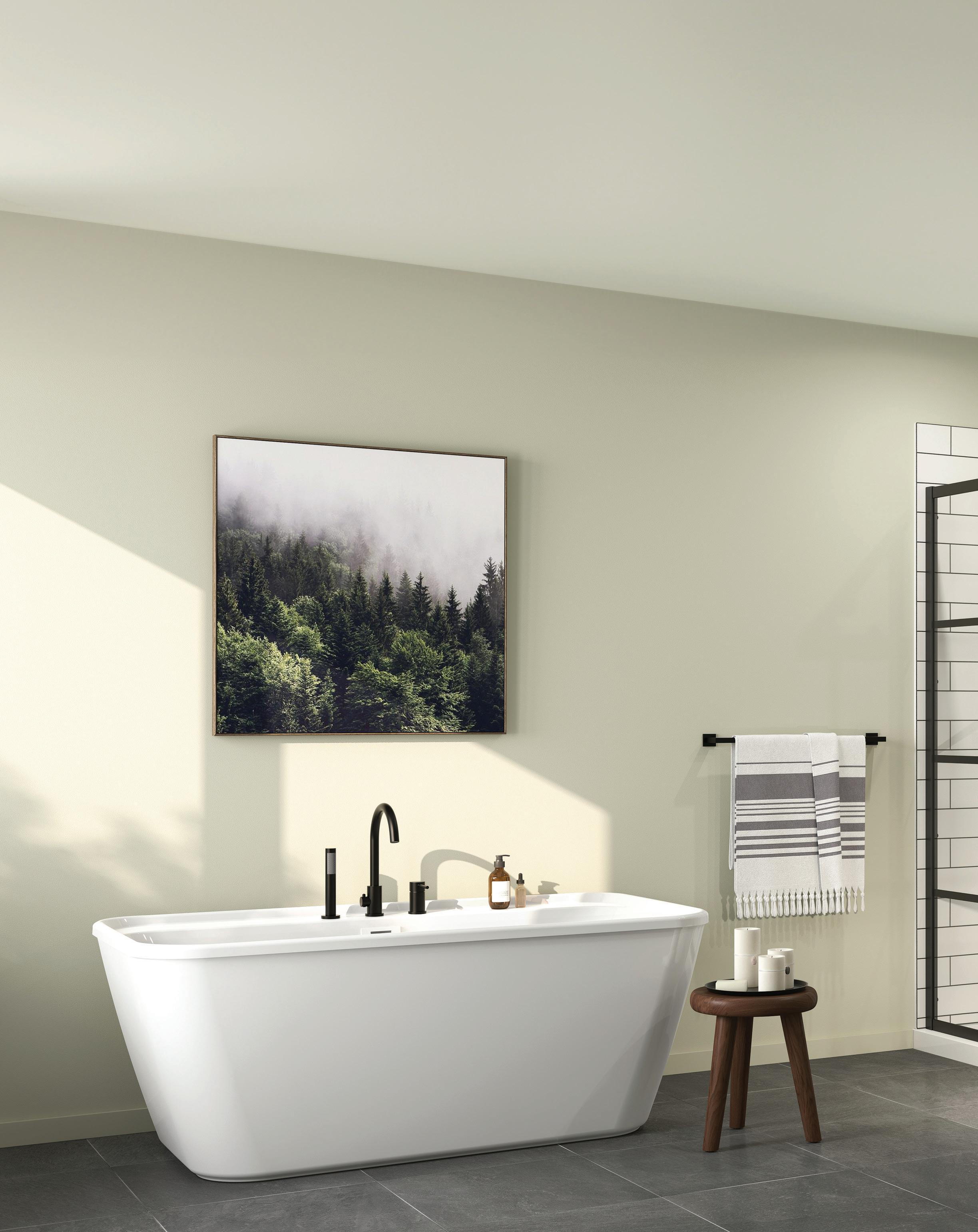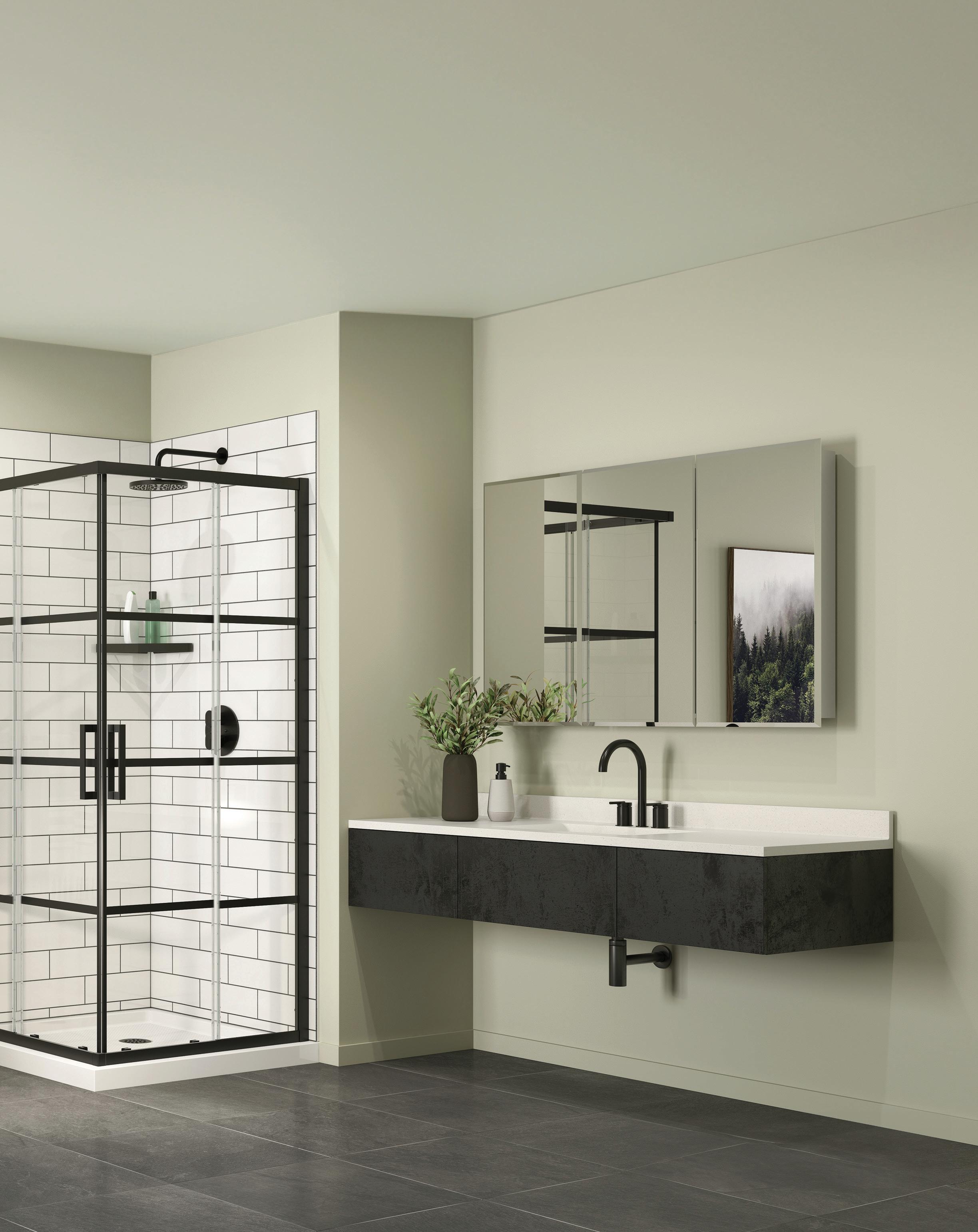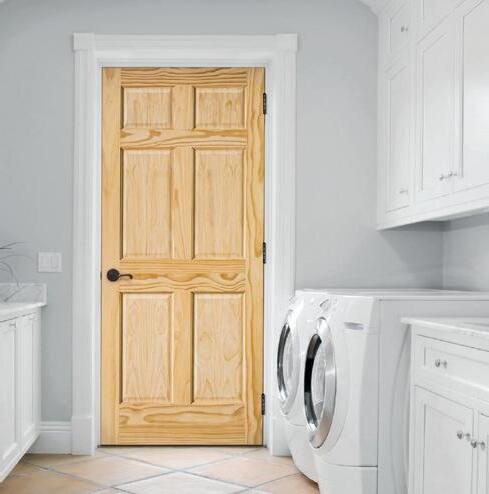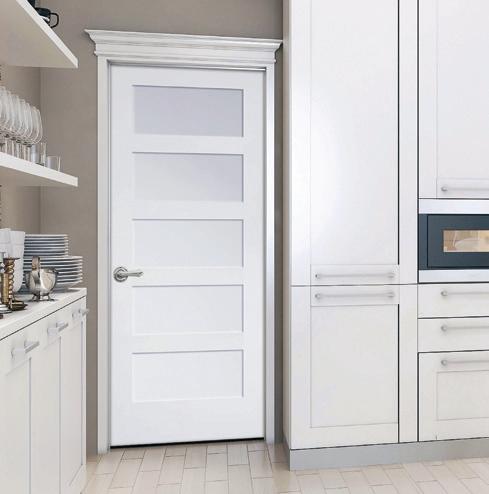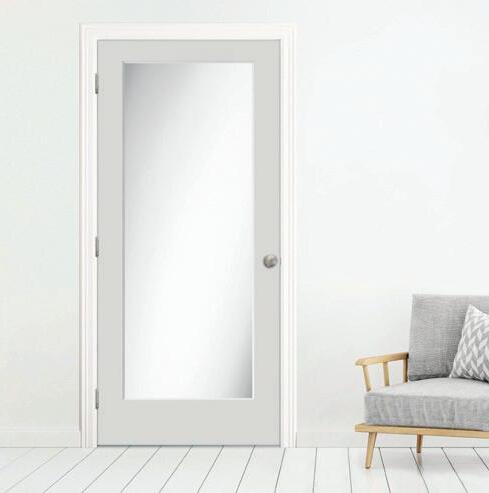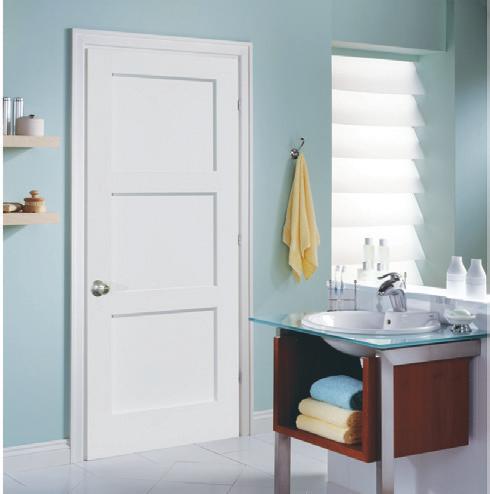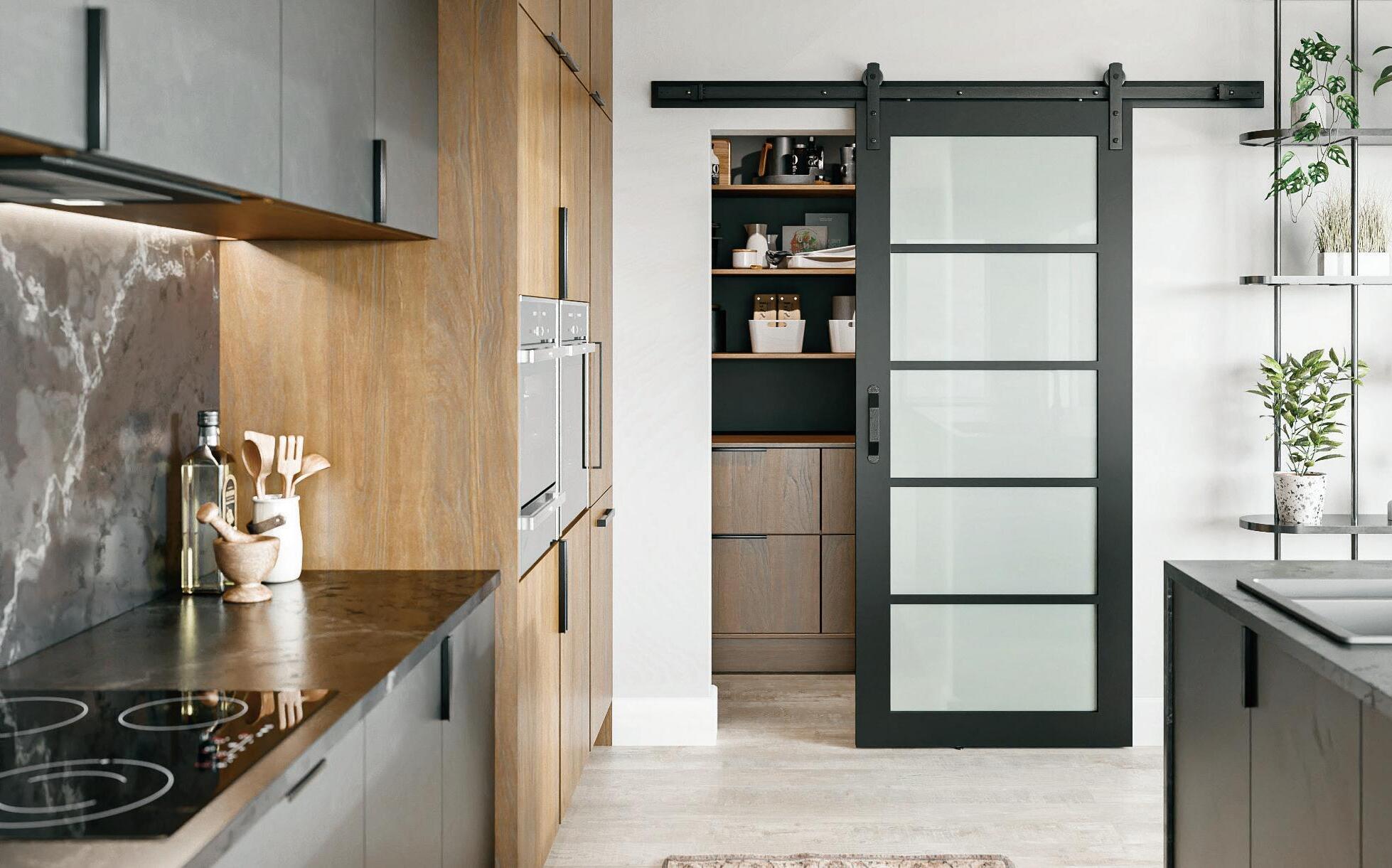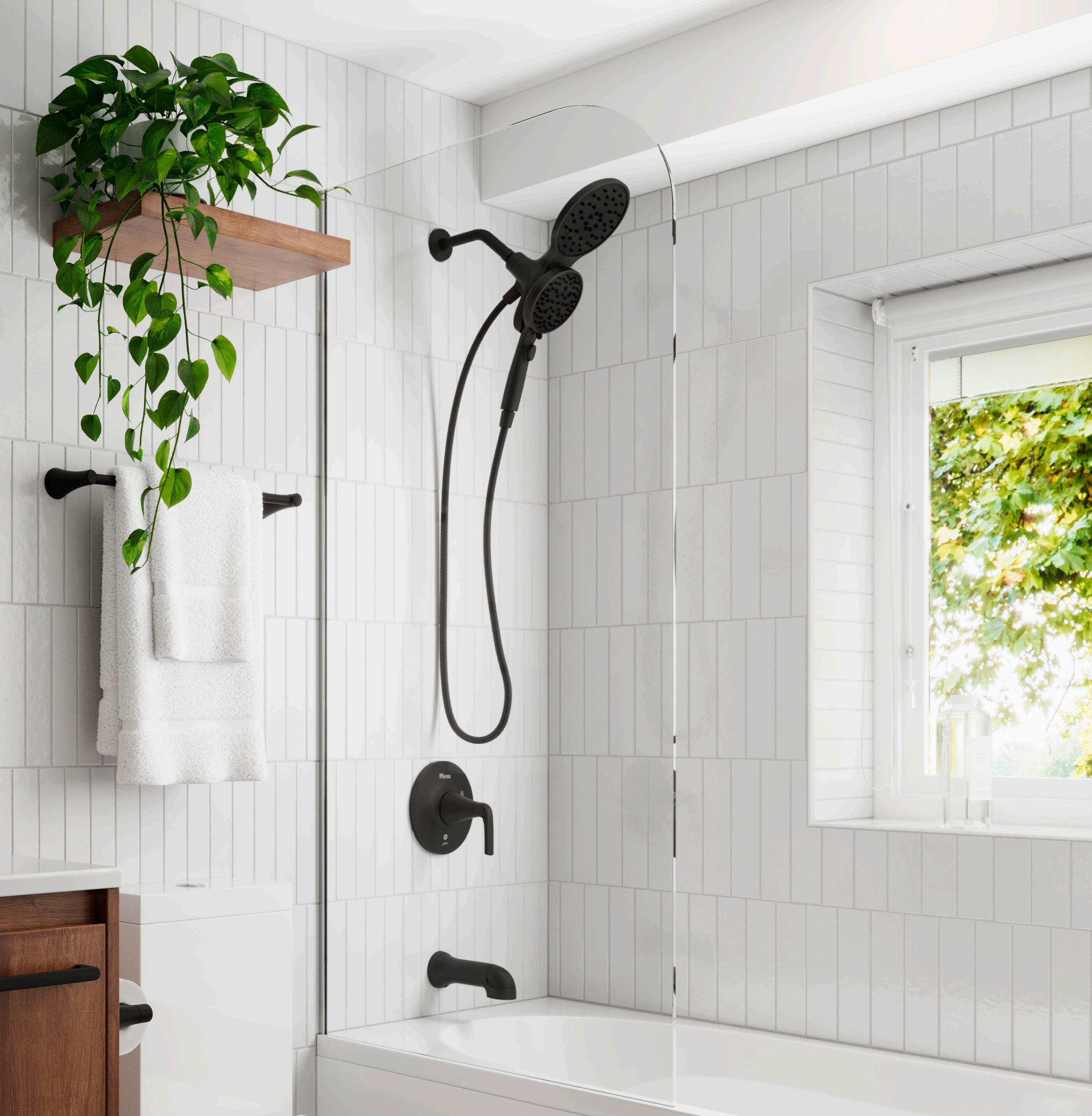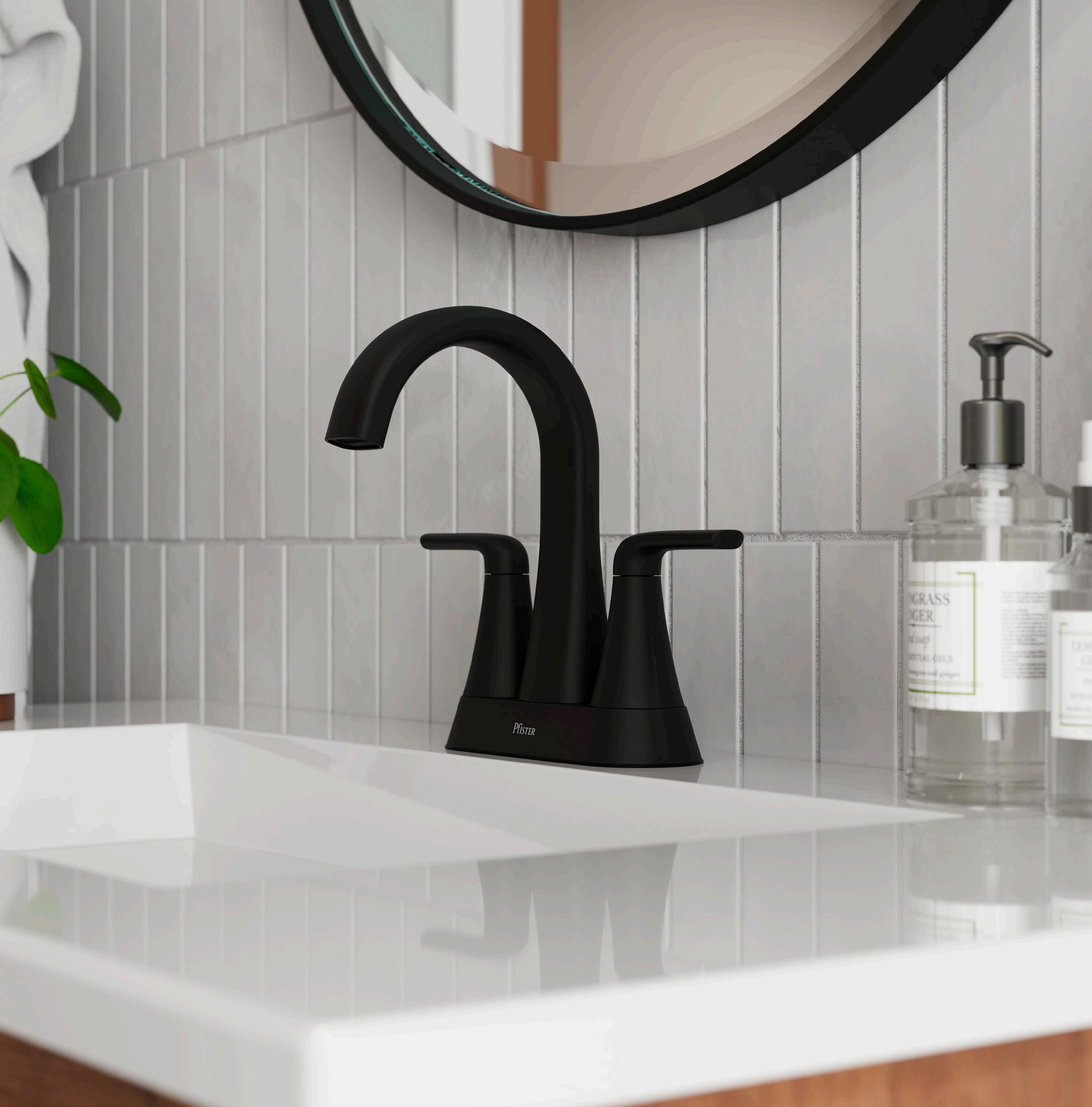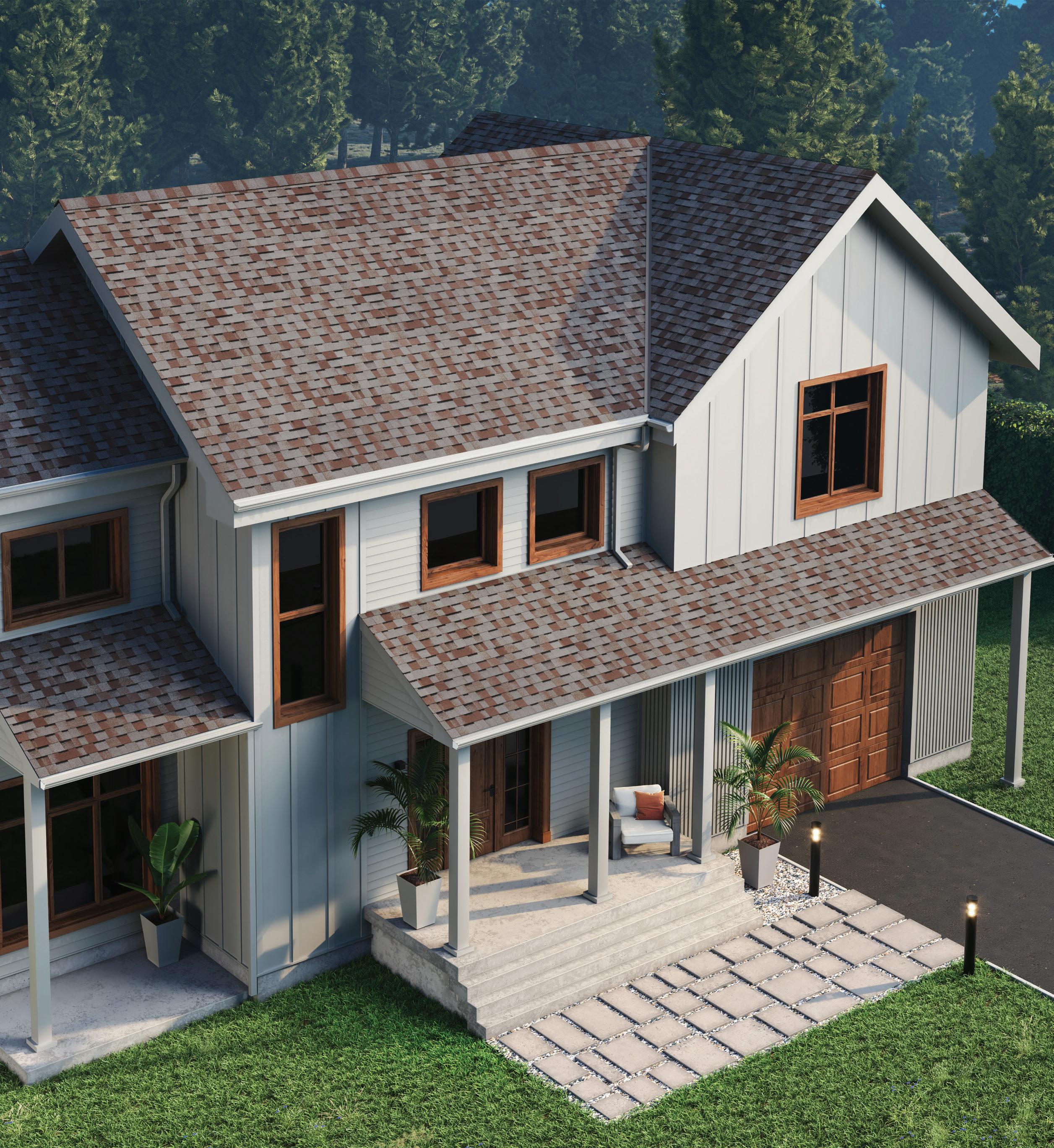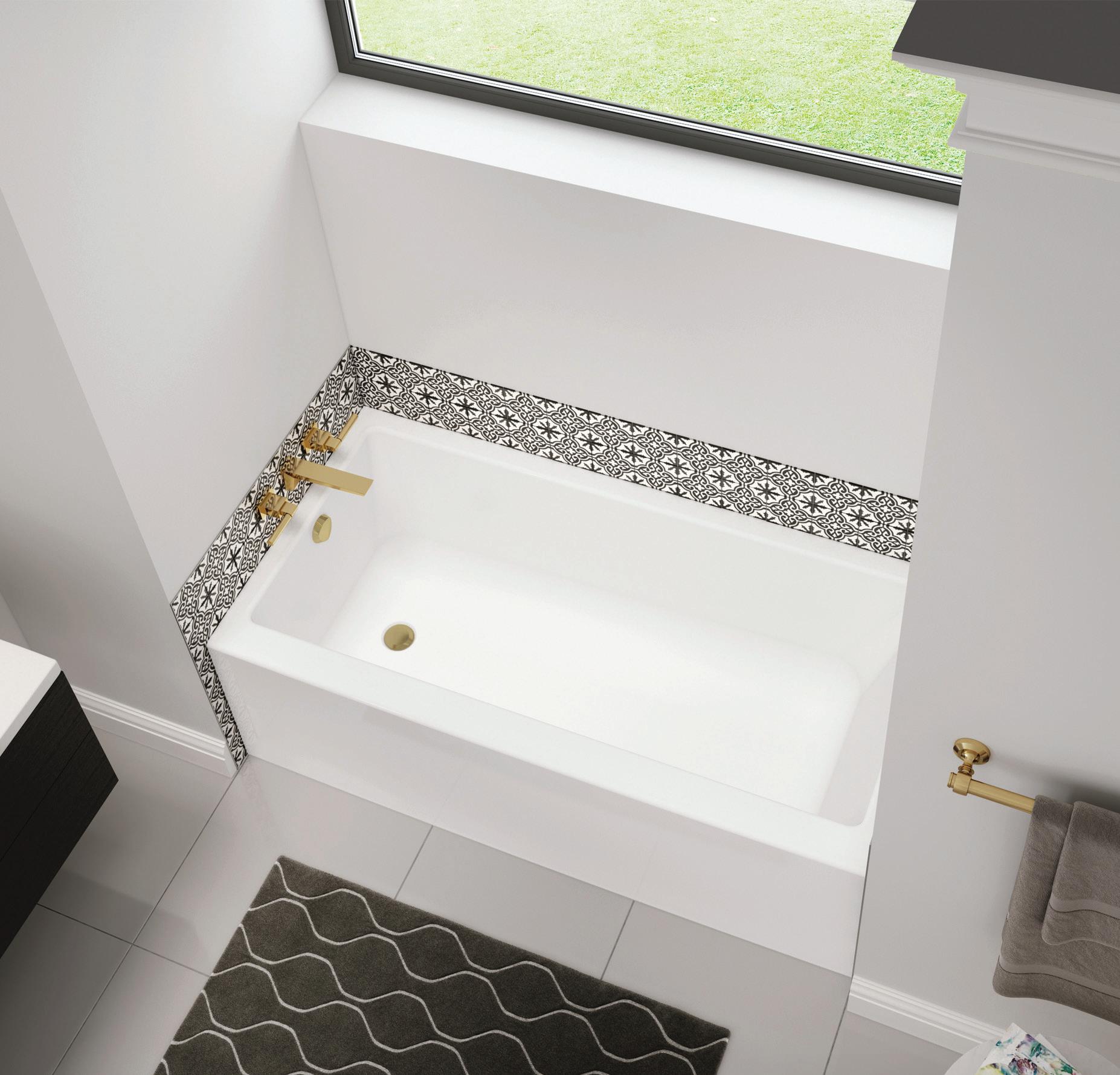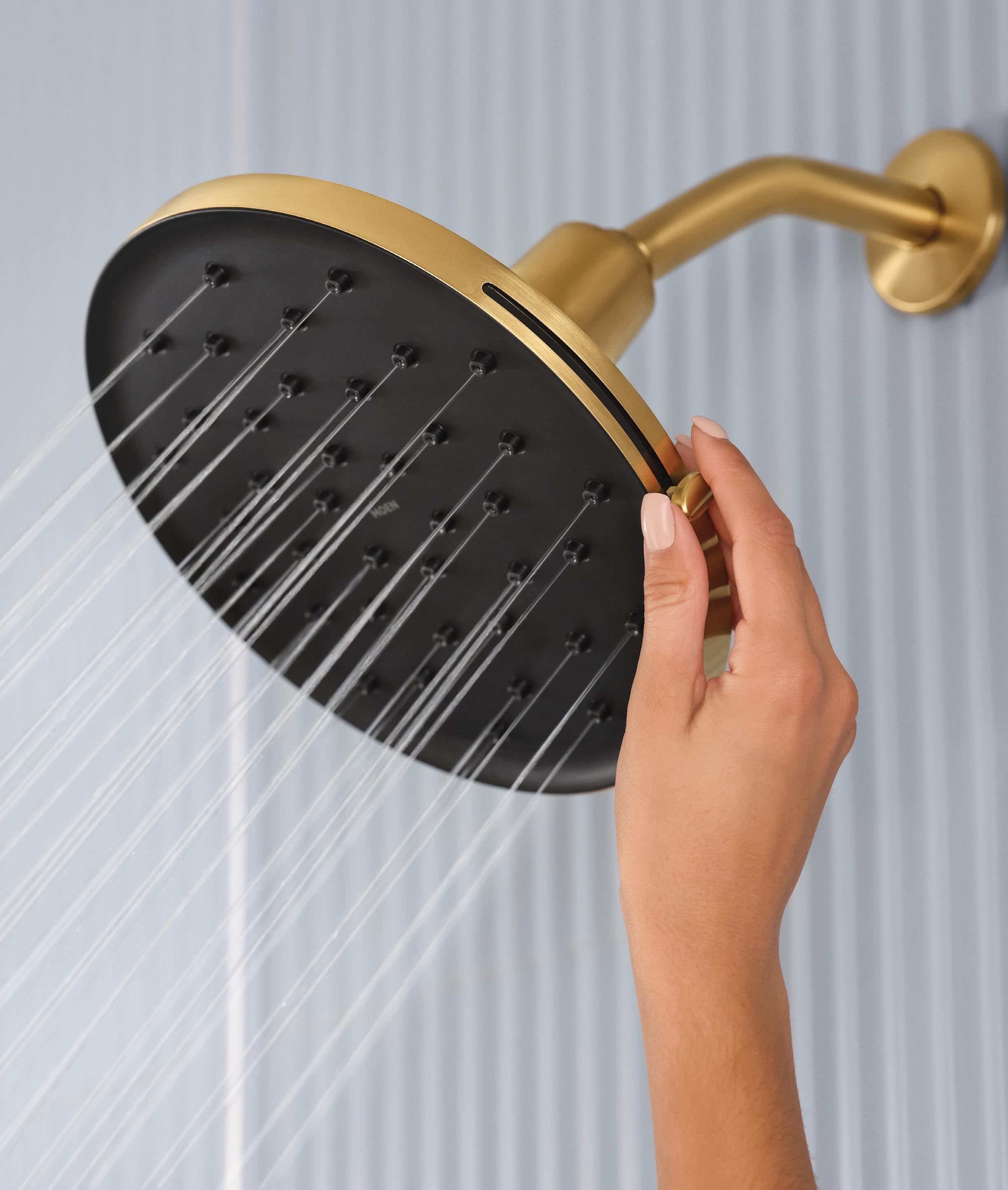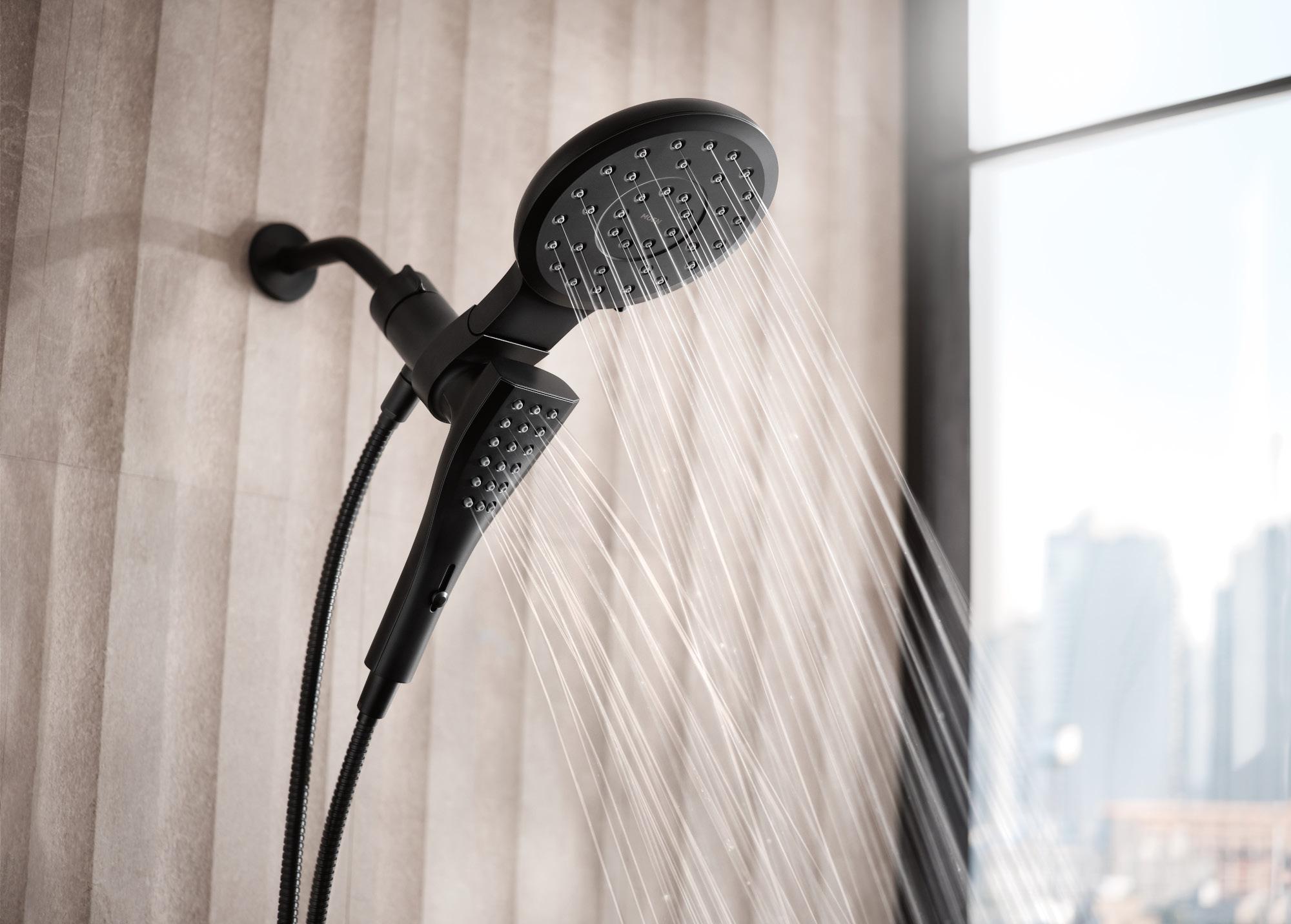2025 CANADIAN LUMBER OUTLOOK
Industry experts share their insights into what to expect in a potentially volatile year.
Written by Lawrence Cummer
Photo courtesy of Gillfor Distribution
After a relatively flat 2024 from a pricing perspective, lumber prices have seen a jump in recent months.
The bulk of last year saw low lumber prices resulting in rotating curtailments, with dealers and distributors running low inventories, until the industry saw a rally around lumber, plywood and OSB come about in the fourth quarter.
“It was pretty bad most of the year, and about 10 weeks ago we saw some activity,” says Kelvin Johnston Senior Buyer, Commodity Lumber and Panels at Castle Building Centres Group Ltd. “It was because sawmills found themselves losing money, so we had a number of curtailments, and in some cases full-on closures, to cut production out of their operations.”
Johnston attributes the rally to supply rather than consumer demand, noting that housing starts are “still not great” and condo starts are “terrible.”
“We reached a point where there was enough production out of the marketplace that there was probably more demand than there was production, all at once now we see the price pick up and we have a full-on rally.”
Photo courtesy of Gillfor Distribution
The lows of 2024’s lumber market were unexpected, suggests Brendon Hiller, Lumber Supply Manager at Taiga Building Products.
“We were surprised how low pricing remained for 2024, we expected with so many curtailments happening that demand would outpace supply,” he says. “This was telling us that The R&R market that makes up for 40% of lumber consumption in North America was very weak, keeping prices down for the first 9 months.”
“With interest rates not coming down in the U.S. you see existing home sales slow drastically, no one is moving which slows the R&R market down.”
Photo courtesy of Taiga Building Products
The fall pricing increase surprised all in the industry, says Brent Brownmiller, Vice President of National Commodity Products at Gillfor Distribution. While it was expected, it was sooner and stronger than anticipated.
“Everybody was surprised by the recent run in lumber prices,” he says. “We all speculated that 2025 was going to be a firmer year when it comes to pricing and availability of lumber, but I don’t think there was anybody who thought it was going to come with such fury so late in the year of 2024.”
Photo courtesy of Gillfor Distribution
Stephen Marshall, President of Futura Forest Products (the treated lumber division of Doman building materials), attributes the flat start to 2024 to accelerated logging activity, especially in Quebec.
“Two things happened structurally with sawmillers in Canada,” he says. “In Quebec, we saw an increase in production early in 2024, and that was due to a lot of forest fire activity in Northern Quebec, and there was a very real beetle threat as a wave of beetles started attacking those burnt
forests. Sawmills had to stock and merchandize those logs as fast as possible.”
In the West, he says, several factors have caused production to drop. Marshall says major increases in softwood lumber duties on shipments going to the U.S. and changing rules put in place by the B.C. government on how sawmills can operate have dropped production over the last decade by approximately 50 percent. He echoes the opinion that the end-of-year rally is supply-driven.
Photo courtesy of Doman Building Materials
Photo courtesy of Doman Building Materials
WHAT TO EXPECT IN 2025
Most are predicting the higher pricing on lumber to continue into 2025, and note the market is rife with potential challenges.
“I do see this continuing in 2025, we will see supply tighten and demand increasing. We should see higher levels and more volatility,” says Hiller. He foresees a “stronger market, tighter supply driving higher levels.”
“Housing starts will be slightly up, but the R&R demand should increase. We expect more mills to keep wood in Canada but with supply being so tight from Canadian producers due to all the curtailments, I don’t think this translates into massive discounts in Canada all the time. It will create a lot of confusion in the marketplace.”
He also forecasts volatility, with the prospect of new U.S. tariffs and another expected increase in softwood lumber duties.
“With the new (U.S.) administration, expect the unexpected. We don’t know what will happen, we focus on what we can control and adjust as needed.”
In August 2024, the U.S. increased import duties on Canadian softwood lumber by nearly 81%, and industry watchers are expecting more to come. Naturally, lumber exports have been down.
With the curtailments of B.C. sawmills resulting from various economic pressures, certain products — longer and wider widths, for example — will be harder to find, Brownmiller says. He notes that 2024 was still “a correction year” after the “astronomical highs” during the Covid-19 outbreak.
He expects the lumber market in 2025 to be firmer and anticipates lead times will increase overall compared to 2024. He also says there are serious concerns ahead.
One possible risk is that Southern Yellow Pine from the U.S. may find its way into Canada, “It almost makes sense, freight-wise, to start bringing wood from the southeast part of the U.S. into the eastern part of Canada.”
Another “massive concern,” of course, is further duties and the impending threat of tariffs under the new U.S. government.
“Right now, the duty impact going into the U.S. is 14.5%, there is a potential that may double at some point this year. So, any Canadian softwood lumber exporting to the U.S. will have up to a 30% impact on duties. That’s massive,” he says. “With
the incoming U.S. President, there could be an extra 10% tariff on top of that.”
Castle’s Johnston predicts consumer demand for lumber products to be flat in the first half of 2025, with the lumber market mirroring that, but expects a pickup in Q3 and Q4, based on increased housing builds, assuming interest rates in Canada continue to drop. He predicts even greater future demand to combat the ongoing housing crisis.
“At some point, we’re going to get on a run and there’s such a housing shortage that it could be for five or six years,” Johnston says.
Photos courtesy of Taiga Building Products
Marshall also predicts a relatively average year: “For 2025. My forecast is fairly muted. We’re still in this period of uncertainty. Leadership changes in the U.S., potential leadership changes in Canada. Lots of uncertainty. Personal debt per household is at relatively high levels,” he says.
“Folks are just being cautious. I think it’s going to be a very average year in 2025. I don’t think the inflation threat, at least in the U.S., is over. Folks are going to be more cautious, so it’s going to be a very sort of stable year. It could mirror what’s happened in 2024.”
Photo courtesy of Doman Building Materials
“We’re not going to set any records in 2025.”
While opinions vary slightly on the year ahead, Hiller has solid advice for contractors looking at a potentially volatile year and longer lead times.
“With tight supply, order files and pricing will be volatile. The past two years we have been
able to get whatever material we need very quickly; this will change as demand increases. Be cautious waiting until the last minute to order material for projects, you may be surprised by the lead times.” —
THE HABIT HACK: REWIRE YOUR BRAIN FOR BETTER CUSTOMER SERVICE
Written by Kate Zabriskie
Companies invest millions of dollars in training each year. Yet, even after extensive education and successful performance in a classroom environment, many seasoned professionals struggle to implement new techniques. Why? The answer lies not in a lack of knowledge but in the power of habit.
Meet Lisa, a customer service manager with 15 years of experience. Despite her expertise, she finds herself stuck in a rut, unable to elevate her team’s performance. “We attend workshops and get fired up about new strategies, but within weeks, we fall back into our old routines. It’s so frustrating.” People like Lisa aren’t outliers. In fact, they are very often the norm.
The culprit? Our brains. Neuroscience reveals that habits, both good and bad, are deeply ingrained neural pathways. These mental shortcuts allow us to navigate daily tasks efficiently, but they can also hinder growth and innovation.
This phenomenon is not unique to customer service. Across industries, from healthcare to finance, professionals find themselves trapped in difficult-to-break cycles of behavior. The brain’s preference for familiar patterns can be both a blessing and a curse. While it allows us to perform complex tasks without conscious effort, it can also make us resistant to change, even when that change is beneficial. So, how can we break free from this cycle and leverage brain science to create lasting change?
IDENTIFY HABIT TRIGGERS
The initial step in rewiring neural pathways is recognizing the habits that hinder progress. Common pitfalls include:
• Reverting to outdated business practices
• Taking shortcuts under pressure
• Becoming overly comfortable with routine tasks
Dedicate time to observing behavior. When do old habits emerge? What triggers them? Identifying these triggers is crucial to interrupting the habit loop. It’s important to note that triggers can be both external and internal. External triggers might include a ringing phone, a crowded queue, or a particularly challenging customer. Internal triggers could be feelings of stress, boredom, or even confidence that leads to complacency. By mapping out these triggers, you create a roadmap for intervention.
DISRUPT ESTABLISHED PATTERNS
Once triggers are identified, it’s essential to introduce disruptions. This process is not about willpower but about creating new neural pathways. Consider these approaches:
• Engage in positive self-reflection: Regularly remind yourself of the habits you aim to cultivate.
• Practice mindful pauses: When faced with an urge to react, take a moment to breathe
deeply. This simple act can interrupt automatic responses.
• Modify the environment: Rearrange workspaces or introduce visual cues that reinforce desired behaviors. The key here is consistency. Each time you successfully disrupt an old pattern, you’re laying the groundwork for a new, more beneficial habit. It’s like creating a new path through a field – the more you walk it, the more defined it becomes.
CULTIVATE IMPROVED HABITS
Eliminating undesirable habits is insufficient; they must be replaced with positive alternatives. Consider these strategies:
• Think about what should occur: Consider all options, not just the tried-and-true choice before responding.
• Embrace thoughtful pauses: Resist the urge to rush. Quality interactions often require patience and careful consideration.
This step is about actively choosing new behaviors that align with your customer service goals. It might involve implementing a new problem-solving approach, adopting a more empathetic communication style, or utilizing technology in innovative ways to enhance customer experiences.
REINFORCE
Neuroscience demonstrates that repetition strengthens neural connections, making new behaviours feel more natural over time. Think about the actions you can take to carve new mental pathways.
• Engage in daily reflection: Allocate time each day to review customer interactions, identifying successes and areas for improvement.
• Acknowledge progress: Set achievable goals and recognize when they are met.
Positive reinforcement can significantly impact habit formation.
• Establish accountability partnerships: Share objectives with colleagues. Regular check-ins can enhance motivation and commitment.
Consider implementing a reward system that recognizes both individual and team efforts in adopting new habits. This could range from public acknowledgment in team meetings to more tangible rewards for consistent improvement.
EMBRACE THE JOURNEY
Rewiring your brain is a marathon, not a sprint. Neuroscientists suggest it takes about 66 days to form a new habit, so patience is necessary. Remember, progress isn’t always linear. You
might have setbacks, but each time you choose a new response, you’re strengthening those neural pathways. Viewing these setbacks not as failures, but as opportunities for learning and refinement is crucial.
“It was challenging at first,” Lisa reflects, six months into her team’s transformation. “But now, our new approach feels second nature. Our customer satisfaction scores have never been higher.”
Understanding the science behind habits and implementing these strategies allows you to break free from old patterns and elevate your customer service to new heights. The result? Happier customers, more engaged employees, and a stronger bottom line. —
TAPPING INTO FAUCET AND FIXTURE TRENDS
Finish is just one consideration for consumers buying new faucets and bath fixtures. It’s got to look good – but automation, water conservation and easy cleanup are important, too.
Written by Lisa Gordon
Holiday silver and gold might be done for another year, but metallics are still gleaming in Canadian kitchens and bathrooms. The latest trends show consumers gravitating towards faucets and
fixtures in chrome, gold, and black. But finish isn’t the only consideration – homeowners want automation, efficiency, and easy cleanup, too.
Photo courtesy of Maax Canada
MODERN MINIMALIST
Rick Pitre is the National Account Manager Residential Segment for ASSA ABLOY, a supplier of Pfister bath products. Pfister manufactures faucets, shower and bath hardware products, with its Canadian headquarters in Mississauga, Ont.
“Pfister specializes in providing customers with showroom-quality products equipped with powerful innovations at affordable prices,” said Pitre, adding that Canadian consumer preferences continue to trend toward a modern-centric look.
As an example, he pointed to Pfister’s Raya line of bath faucets, noting their sleek, soft-modern design.
While many customers prefer matte black finishes, they also want easy-clean features like smudge resistance. In response, Pfister created its Spot Defense® finish, which resists fingerprints, water marks, and soap residue. “We see this faucet (with Spot Defense) is highly favoured, which is why new products we develop going forward will include this innovation,” said Pitre.
Gold is still popular, but its growth has stagnated. Pitre feels this is likely because some customers are still hesitant to add a brushed gold finish to their homes. He predicts that gold will become
an accent colour on bath fixtures moving forward: “It is likely that mixed finishes (e.g., matte black with a hint of gold) will increase in popularity in the future.”
Photo courtesy of ASSA ABLOY
Pitre said company research has shown that finish is one of the first factors in the consumer decision-making process. Online shoppers are more likely to opt for a different finish than the current polished chrome in their homes. It’s a different story with those who shop in-store.
“Those who research online and look at different design trends are more likely (than those who shop in person) to change finish and move towards something such as matte black or brushed gold.”
Customers are looking to create a cohesive look in their bathrooms. They want to ensure finishes
match throughout, including on the faucet, bath hardware, tub and shower, and even the door lock.
As important as finish is to consumers, they are also looking for “high-quality products at affordable prices,” noted Pitre. He said Pfister aims to price its products competitively, while adding that customers benefit from innovations that aren’t accompanied by premium prices. Some examples include MagnePfit magnetic docking and Top Pfit (which allows customers to install faucets above the deck), as well as Spot Defense.
Environmental impact has been on the minds of manufacturers and consumers alike. Sustainability is very important to Pfister, said Pitre, and the company is always looking for ways to reduce packaging and waste. As well, all Pfister products are WaterSense certified, meeting U.S. Environmental Protection Agency (EPA) criteria for efficiency and performance. WaterSense certified products use at least 20 percent less water
compared to average products in their category, yet perform as well or better than other models.
Moving through 2025, “modern designs will remain popular in Canada, and minimalist designs will become increasingly popular,” said Pitre, adding that less is more in the Canadian fashion plumbing market, which is very focused on the ultra-modern.
Photo courtesy
MATTE BLACK STAYS INTACT
Maax Canada is headquartered in Lachine, Que., and produces bathtubs, shower bases and kits, shower doors and tub and shower walls. Dan Raschella, Maax Bath’s Key Account Manager for Castle Building Centres, said the company has seen many changes in style and innovations over its 50-plus years of operation – but it’s always looking to extend its lineup.
Raschella said chrome is still the number one choice for shower door handles, although matte black has gained market share in the last two to three years.
“I would say matte black is number two now, followed by brushed nickel or stainless steel,” he
said, adding that mixed metals, brushed gold and combined accents are niche trends.
Low-maintenance products are still high on a consumer’s list of must-haves. Select Maax shower doors are available with Lotus easy clean glass protection, a super-hydrophobic coating that protects the glass, making it easier to clean. “There is always a little maintenance involved, but people are looking for as little as possible,” said Raschella.
Square shapes and clean lines are still driving the market, with design trends often filtering down from Europe. International trade shows have a strong influence, whether sparking innovative ideas or breathing new life into previous trends.
Photo courtesy of Maax Canada
“A lot of our product managers are travelling around to see what is happening elsewhere, not just in North America. People want quality for the dollar they are spending, more than ever before.”
For instance, thicker glass is being used for shower doors that now run along quiet, sturdy rollers while remaining aesthetically pleasing – and these are making large gains in the market.
Raschella says Maax Bath understands consumers’ environmental concerns and the company is very conscientious about reducing and reusing materials. All Maax tubs are made in Canada, as well as most of their acrylic products. Most acrylic waste cuts are
recycled and packaging is as environmentally friendly as possible.
“There is value in being made in Canada,” he said. Clean lines with a chrome finish will continue as a mainstay in the market for 2025, according to Raschella. He also said that matte black seems like it’s here to stay, although it looked like a trend just a couple of years ago.
Finally, he sees accessibility projects trending upwards due to an aging population, with a greater demand for “showers with low thresholds, easy access, grab bars, and things of that nature to help people in and out of the enclosure.”
Photo courtesy of Maax Canada
THE LUXURY OF GOLD
Moen offers a wide selection of kitchen and bath faucets, showerheads, accessories and bath safety products. Michael Mackan, Senior Sales Representative & Account Manager at Moen Canada, said, “Our thoughtful designs deliver an exceptional user experience and elevate the way people interact with water every day.”
Mackan added that Moen is committed to enhancing the customer experience while offering style options that meet their personal needs. The Infiniti™ Dial found on the Moen Verso Shower is an example of this commitment. Innovated with a variety of spray options without a pause, the design is meant to enhance customer experience. “Users can simply slide the dial to seamlessly switch between modes and enjoy an uninterrupted flow.”
Moen’s 2024 Design Trend Report found that personal expression as a whole is on the rise.
One example of this expression is the choice of faucet finish. Mackan pointed to matte black as an example, because of its ability to heighten both classic and contemporary designs. Moen’s new bronzed gold finish has also gained popularity with those looking to add a “touch of luxury.”
“Biophilic design, or the concept of incorporating nature into the home, is also on the rise,” continued Mackan. Consumers are looking for a connection to the outdoors, so they are choosing natural materials and textures that evoke a sense of calm. “In faucets, this is reflected through the incorporation of modern organic elements in terms of shapes and textures.”
Mackan sees a growing preference for advanced technology in the faucet market. Moen’s Smart Faucet offers convenience features that consumers are looking to embrace, such as control with voice or hand motions.
Photos courtesy of Moen
Consumers are also looking for finishes that ultimately complement their space, but also align with their lifestyle and design vision.
“Brushed and bronzed gold tend to offer a more luxurious feel, while matte black is often chosen for its contemporary appeal and versatility,” said Mackan, adding that the choice always comes down to individual preference.
Of course, hygiene remains a top concern in bathrooms. Touchless technology promotes a more sanitary experience and spot resistant finishes enable easy cleanup. Features like these are driving a trend that prioritizes functionality and cleanliness, without compromising on style. Products such as grab bars promote accessibility for all ages and these are on the rise due to an increase in multigenerational homes.
“Consumers want products that are built to last, with finishes that resist corrosion and tarnishing, making them easy to clean and maintain,” observed Mackan.
He noted that sustainability is increasingly important to customers and said Moen strives to meet consumer expectations. Products such as the Verso Rainshower with Magnetix, which uses recycled ocean plastic to create the innovative Magnetix docking system, or the Beric bathroom faucet that meets EPA WaterSense criteria, are examples of the company’s achievements.
“Our conservation commitment, known as Mission Moen, aims to save one trillion gallons of water and repurpose 2,000 tons of ocean plastic by 2030,” explained Mackan.
Ultimately, he concluded, consumers continue to seek out products that simultaneously better their experiences with water, while enhancing the overall aesthetic of their space.
It seems the 2025 faucet and bath fixture market will be characterized by clean lines and coloured with chrome, gold and black. With a multitude of designs, features and options to consider, consumers are sure to find faucets and fixtures that shine with their own personal style. —

